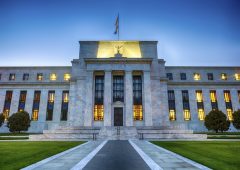China Begins Stimulus Plan to Address Debt and Spur Economic Growth
09.11.2024 10:00 1 min. read Kosta Gushterov
On November 8, China unveiled a major stimulus plan, allowing local governments to issue an additional $827.7 billion in bonds over the next three years to address rising "hidden debt."
This comes after previous interest rate cuts, but analysts suggest China must spend up to $1.4 trillion annually to recover from a prolonged property slump.
The National People’s Congress approved this fiscal expansion, raising the local government debt ceiling from 29.52 trillion yuan to 35.52 trillion yuan. The government’s hidden debt surpassed 14 trillion yuan by 2023, with plans to reduce it to 2.3 trillion yuan by 2028. The IMF reports the total government debt at 147 trillion yuan, or 117% of GDP.
While the scale of the overall stimulus is still unclear, analysts expect an increase in debt issuance to up to 10 trillion yuan in the coming years, potentially reducing annual interest payments. The package is focused on long-term structural issues rather than immediate recovery, with little direct consumer support. Economists warn that while the stimulus is vital to meet growth targets, it may not significantly boost domestic consumption or confidence.
The NPC also approved 6 trillion yuan in special bonds to recapitalize state banks, with fiscal deficit targets expected to rise by 2025. Experts stress that further targeted fiscal spending on local debt and households will be necessary to reignite consumer confidence and drive sustainable growth.
-
1
Trump Targets Powell as Fed Holds Rates: Who Could Replace Him?
27.06.2025 9:00 2 min. read -
2
U.S. PCE Inflation Rises for First Time Since February, Fed Rate Cut Likely Delayed
27.06.2025 18:00 1 min. read -
3
Key U.S. Economic Events to Watch Next Week
06.07.2025 19:00 2 min. read -
4
Gold Beats U.S. Stock Market Over 25 Years, Even With Dividends Included
13.07.2025 15:00 1 min. read -
5
U.S. Announces Sweeping New Tariffs on 30+ Countries
12.07.2025 16:30 2 min. read
US Inflation Heats Up in June, Fueling Uncertainty Around Fed Cuts
U.S. inflation accelerated in June, dealing a potential setback to expectations of imminent Federal Reserve rate cuts.
Gold Beats U.S. Stock Market Over 25 Years, Even With Dividends Included
In a surprising long-term performance shift, gold has officially outpaced the U.S. stock market over the past 25 years—dividends included.
U.S. Announces Sweeping New Tariffs on 30+ Countries
The United States has rolled out a broad set of new import tariffs this week, targeting over 30 countries and economic blocs in a sharp escalation of its trade protection measures, according to list from WatcherGuru.
Key U.S. Economic Events to Watch Next Week
After a week of record-setting gains in U.S. markets, investors are shifting focus to a quieter yet crucial stretch of macroeconomic developments.
-
1
Trump Targets Powell as Fed Holds Rates: Who Could Replace Him?
27.06.2025 9:00 2 min. read -
2
U.S. PCE Inflation Rises for First Time Since February, Fed Rate Cut Likely Delayed
27.06.2025 18:00 1 min. read -
3
Key U.S. Economic Events to Watch Next Week
06.07.2025 19:00 2 min. read -
4
Gold Beats U.S. Stock Market Over 25 Years, Even With Dividends Included
13.07.2025 15:00 1 min. read -
5
U.S. Announces Sweeping New Tariffs on 30+ Countries
12.07.2025 16:30 2 min. read


